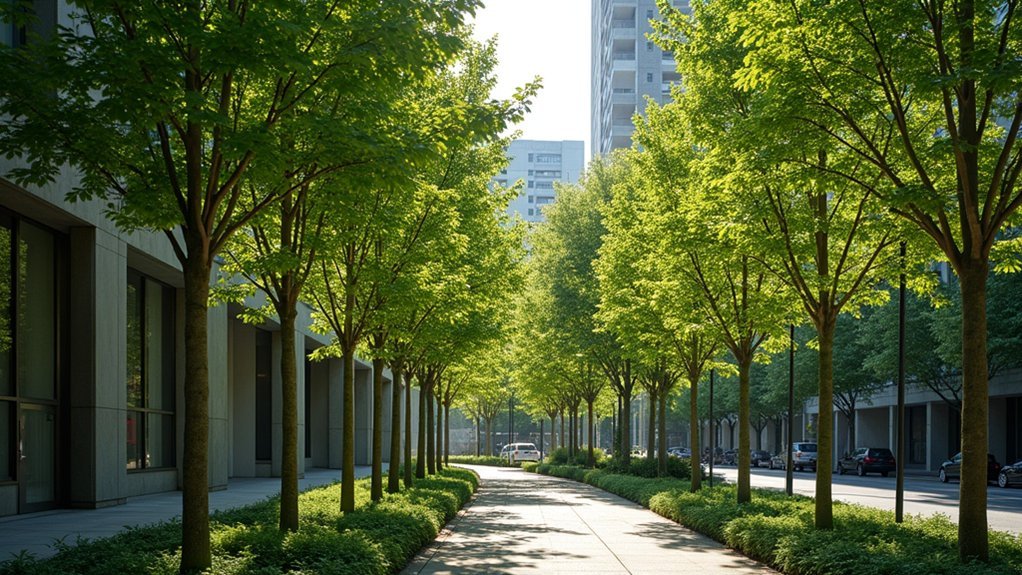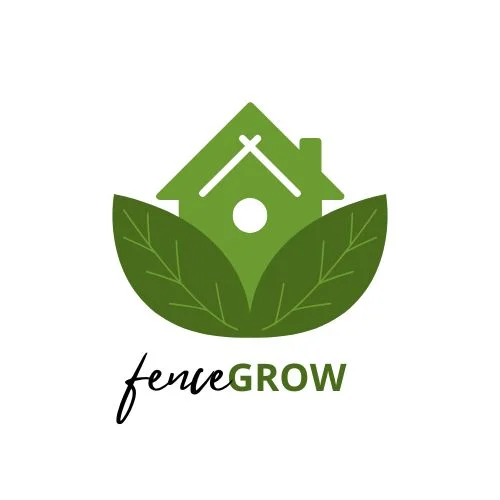Slender columnar trees create effective privacy screens in limited spaces, staying just 2-3 feet wide while reaching heights of 20-60 feet. You’ll find excellent options in Italian Cypress, Skyrocket Juniper, and Emerald Green Arborvitae, which form dense natural barriers that block views and reduce noise. Their vertical growth requires minimal pruning and works perfectly for urban settings and small yards. Discover how these living walls can transform your landscape with year-round privacy and seasonal beauty.
Slender Columnar Trees for Privacy Screens

When space is limited but privacy is essential, slender columnar trees offer an elegant vertical solution for your landscape. These narrow specimens typically stay within 2-3 feet wide while creating effective natural screens and windbreaks.
You’ll find excellent options like Italian Cypress with its distinctive spire-like form, or the drought-tolerant Skyrocket Juniper with dense blue-green foliage. Regal Prince Oak works well in tight rows, while Slenderina Weeping Blue Spruce doubles as both screen and focal point.
These trees feature fastigiate branching—upward growth close to the trunk—requiring minimal pruning to maintain their clean vertical lines. Italian Cypress, one of the fastest growing options, can add an impressive 2 to 3 feet of height annually.
Plant them closely for dense privacy screens, frame entrances in pairs, or arrange them in semi-circular patterns for visual interest. They’ll provide year-round privacy while enhancing your landscape’s vertical dimension.
Why Columnar Trees Excel as Natural Privacy Barriers
Columnar trees offer a space-efficient solution for your privacy needs with their striking vertical growth that reaches heights of 20-60 feet while maintaining a slim 2-6 foot width.
Their densely packed branches create a natural living wall that effectively blocks unwanted views and reduces noise from neighboring properties. These versatile trees can be arranged in formal, symmetrical arrangements or informal groves depending on your landscape design preferences.
You’ll enjoy privacy year-round with evergreen varieties or can opt for deciduous columnar trees that provide seasonal screening while allowing winter sunlight to warm your landscape.
Space-Maximizing Vertical Growth
Unlike their spreading counterparts, slender columnar trees maximize your available space through remarkable vertical growth patterns. Reaching heights of 40+ feet while spanning only 4-12 feet wide, these trees transform limited horizontal space into impressive vertical barriers.
You’ll find their fastigiate branching creates natural spire-like shapes that block sight lines and reduce noise without overwhelming your landscape. This upright habit minimizes shading of adjacent plants, allowing you to maintain usable ground area for other garden elements.
The efficient vertical structure works perfectly in urban settings, small yards, or tight spaces where standard trees wouldn’t fit. These sentinel-like trees deliver vertical impact by adding architectural interest and definition to your property borders. Plant them in rows for privacy screens without worrying about overcrowding or excessive root competition.
Their ability to grow up rather than out makes them ideal solutions for modern space-conscious landscaping.
Dense Foliage Barrier
The true beauty of columnar trees as privacy screens lies in their exceptional foliage density, creating natural living walls that traditional fencing simply cannot match. Their tightly packed leaves form impenetrable barriers while maintaining a sleek, vertical profile. For those seeking an alternative, the 100 Series FenceBlock offers 98% opacity for comparable privacy protection.
| Variety | Foliage Density | Seasonal Coverage | Space Efficiency |
|---|---|---|---|
| Emerald Green Arborvitae | Extremely dense | Year-round | Excellent for narrow spaces |
| Thuja Green Giant | Very dense | Continuous | Rapid growth solution |
| Skip Laurel | Dense with glossy leaves | All seasons | Adapts to limited sunlight |
| Leyland Cypress | Delicate but effective | Year-round | Elegant pyramidal form |
You’ll appreciate how these varieties thrive in various light conditions while maintaining their screening capability. Unlike artificial barriers, they provide a living, breathing solution that enhances your landscape’s natural beauty while ensuring your privacy remains protected.
Multi-Season Privacy Solutions
When selecting trees for year-round privacy, columnar varieties offer exceptional benefits that extend well beyond a single season. Their consistent vertical structure maintains privacy barriers throughout the year, unlike deciduous species that lose coverage in winter.
You’ll appreciate how spring-flowering varieties like Malus ‘Maypole’ combine privacy with seasonal beauty, while summer brings lush, dense foliage that effectively blocks unwanted views.
Even in autumn, many columnar trees maintain their screening capabilities while some add spectacular fall color to your landscape. The Javelin Flowering Pear displays vibrant orange-red foliage in fall while maintaining its narrow columnar shape perfect for privacy screens.
Evergreen columnar varieties truly excel in winter when privacy is often most compromised in traditional landscapes. They’ll continue providing shelter, blocking noise, and creating protective microclimates when other trees stand bare.
This year-round functionality makes them invaluable for consistent privacy without sacrificing aesthetic appeal.
Top 5 Fast-Growing Columnar Species for Immediate Privacy
Creating an instant privacy screen often tops the priority list for homeowners seeking seclusion from neighboring properties.
Fortunately, several columnar species offer rapid growth and substantial height.
Columnar varieties provide quick vertical screening without consuming precious landscape space.
Leyland Cypress reaches impressive heights of 60-70 feet with feathery blue-green foliage.
Thuja Green Giant grows 20-40 feet tall while maintaining a relatively slim 10-15 foot width with bright green year-round foliage.
Italian Cypress provides a Mediterranean aesthetic, growing 30-40 feet tall but only 3-5 feet wide with dark green foliage.
For smaller spaces, consider Blue Arrow Juniper, reaching 12-15 feet with striking blue-green foliage and silver berries.
Skyrocket Juniper offers similar benefits, growing 15-20 feet tall while staying exceptionally narrow, featuring attractive blue-green foliage that thrives in full sun.
For optimal coverage and faster results, consider staggering your plantings in two offset rows with 6-8 feet between trees diagonally.
Designing Your Living Fence: Spacing and Arrangement Tips

Successfully designing your living fence requires thoughtful planning of both spacing and arrangement to achieve ideal privacy and aesthetic appeal.
When positioning your columnar trees, follow the layered approach—place taller varieties at the back, mid-sized plants in the middle, and ground covers in front to create visual depth.
Consider your trees’ mature widths and leave appropriate spacing to prevent overcrowding while maintaining privacy. Most columnar varieties need 3-5 feet between plants, depending on their mature spread. Your living fence will serve as a natural sound barrier while providing privacy and defining your property boundaries.
Remember to create access paths for maintenance, and prepare your soil thoroughly before planting.
For a balanced look, you can either maintain symmetry with evenly spaced trees or create intentional asymmetry using different heights.
Incorporate plants with varying textures and seasonal interest to enhance your living fence’s visual impact.
Seasonal Considerations: Evergreen vs. Deciduous Options
When designing your living fence, you’ll need to choose between evergreen trees that maintain privacy year-round and deciduous varieties that create seasonal gaps during winter months.
Evergreens offer consistent screening with minimal maintenance, while deciduous options reward you with spectacular color changes throughout the seasons.
Your climate, screening needs, and aesthetic preferences will ultimately determine which option works best for your landscape. Italian Cypress and Thuja Green Giant are excellent choices for narrow spaces as they provide vertical accents while maintaining a slender profile.
Subheading Discussion Points
Choosing between evergreen and deciduous columnar trees represents one of the most significant decisions you’ll make when planning a privacy screen. Your selection will affect both functionality and aesthetics throughout the year.
Consider these key factors when deciding:
- Seasonal privacy needs – Evergreens provide year-round screening while deciduous trees offer privacy primarily during growing seasons.
- Maintenance requirements – Deciduous varieties need less upkeep after leaf drop, while evergreens require consistent care.
- Visual preferences – Deciduous options deliver dramatic seasonal color changes; evergreens maintain consistent blue-green foliage.
- Climate adaptability – Many evergreen columnars excel in drought conditions, while deciduous varieties often offer better windbreak properties. For immediate privacy concerns, Emerald Green Arborvitae with its compact 4 ft width and dense foliage makes an excellent hedge choice.
Both options can be strategically combined in layered landscaping to maximize privacy while creating visual interest throughout changing seasons.
Year-Round Visual Barriers
Creating an effective visual barrier requires understanding the fundamental differences between evergreen and deciduous columnar trees. For year-round privacy, evergreens like Arborvitae and Italian Cypress maintain their dense foliage regardless of season, while deciduous options like Maple and Oak trees offer coverage only during warmer months. Among these options, the Italian Cypress stands out with its impressive tall, slender profile that can reach up to 50 feet in height while maintaining a narrow 4.5-foot width.
| Tree Type | Privacy Level | Best Features |
|---|---|---|
| Evergreen | Year-round | Constant screening, noise reduction |
| Deciduous | Seasonal | Summer shade, winter light penetration |
| Mixed Planting | Variable | Ecological diversity, visual interest |
When selecting your privacy screen, consider your specific needs. If you’re looking for complete year-round coverage, evergreens are your best choice. They’ll provide consistent visual blockage, noise reduction, and wind buffering. For spaces where winter sunlight is desirable, deciduous varieties might better serve your changing seasonal requirements.
Seasonal Color Changes
Seasonal color changes add another dimension to your privacy screen decision beyond just year-round coverage.
Evergreens maintain consistent privacy while exhibiting subtle color shifts from bronze to yellow hues during colder seasons or drought stress. Many broadleaf evergreens like the Gulf Stream heavenly bamboo develop rich red tones in winter when placed in full sun locations.
Deciduous options deliver dramatic visual impact but sacrifice winter screening when leaves drop.
Consider these seasonal factors:
- Privacy consistency – Evergreens provide year-round screening while deciduous trees leave winter gaps
- Color impact – Deciduous varieties offer spectacular autumn displays before leaf drop
- Mixed plantings – Combining both types balances privacy needs with seasonal interest
- Environmental response – Local conditions affect color intensity and timing
Your microclimate will influence color vibrancy and duration, with sun exposure, soil type, and temperature fluctuations all playing important roles in how your privacy screen transforms throughout the year.
Creating Depth With Multi-Layered Columnar Plantings
While a single row of columnar trees provides basic privacy, thoughtfully designed multi-layered plantings transform your screen into a dynamic landscape feature with remarkable visual depth.
Position your columnar trees as the tallest backdrop layer, then integrate midground shrubs (2-6 feet) and foreground perennials (1-2 feet).
For maximum impact, underplant your columnar specimens with shade-tolerant groundcovers and low-growing perennials that contrast in texture and foliage color.
This approach not only enhances visual complexity but improves ecological function through diverse root depths and seasonal variation. Native plants are particularly beneficial as they support more caterpillars which are essential food sources for local bird populations.
Create multiple horizontal rows with varying heights to achieve true three-dimensional depth.
Complete your design with strategic mulching to unify the composition visually while improving moisture retention beneath your trees.
This layered approach maintains year-round interest while maximizing privacy benefits.
Urban Solutions: Columnar Trees for Tight Property Lines

Urban landscapes present unique spatial challenges that columnar trees elegantly solve by maximizing vertical growing space while minimizing horizontal footprint.
Columnar trees: nature’s skyscrapers for compact urban spaces, reaching skyward without crowding sidewalks or foundations.
You’ll find these slender varieties particularly valuable when working with limited space between buildings or along narrow property boundaries.
These space-efficient trees deliver multiple benefits for city dwellers:
- Space Optimization – Their compact growth habit fits perfectly in tight spaces where traditional spreading trees wouldn’t work.
- Privacy Enhancement – Dense branching creates effective visual screens from neighbors and busy streets.
- Low Maintenance – Their naturally columnar form requires minimal pruning compared to trees that need shaping.
- Property Value Boost – Adding architectural interest with these vertical elements increases curb appeal and real estate value.
Consider varieties like Regal Prince Oak or Emerald Green Arborvitae for your urban property line solutions. Options like Armstrong Gold Maple offer striking landscape features with brighter fall colors that transform from gold to golden orange.
Complementary Plantings to Enhance Your Natural Screen
Creating a truly effective privacy screen requires more than just columnar trees standing alone.
By introducing a layered approach with complementary plants, you’ll achieve both enhanced privacy and visual interest throughout the seasons.
Consider adding climbing vines like clematis or fragrant star jasmine to trellises between your columnar trees.
Beneath these, incorporate small shrubs like Photinia for year-round density.
Tall grasses such as miscanthus can provide movement, sound, and airy texture in sunny spots.
For maximum ecological benefits, arrange plants in a zig-zag pattern and include native species to support local wildlife.
Evergreen shrubs like boxwood and laurel will ensure your privacy screen maintains consistent greenery throughout the year, even during winter months.
Select varieties with different flowering times and foliage colors to guarantee your screen remains attractive year-round.
Don’t forget to prepare soil with organic matter for quicker establishment and stronger growth.
Frequently Asked Questions
How Do Columnar Trees Affect Home Foundation Integrity?
Columnar trees typically affect your home’s foundation less than larger species, but they can still cause damage. You’ll want to plant them at a safe distance and install root barriers to prevent soil shifts.
Can Columnar Trees Be Grown Successfully in Containers?
Yes, you can grow columnar trees successfully in containers. They thrive with well-draining soil, regular watering, and at least six hours of sunlight daily. You’ll need to repot them every 2-3 years.
What’s the Lifespan of Popular Columnar Privacy Trees?
Popular columnar trees have varying lifespans: Weeping Persimmon lasts about 75 years, Arborvitae ranges from 40-150 years, while Swedish Columnar Aspen typically lives only 10 years due to disease susceptibility. You’ll need to take into account longevity when planning.
How Do Utility Lines Impact Columnar Tree Placement?
You’ll need to place columnar trees 15-25 feet from overhead utility lines and research underground line locations before planting. For areas directly under wires, choose varieties under 25 feet tall at maturity.
Are There Deer-Resistant Columnar Trees for Rural Properties?
Yes, you’ll find several deer-resistant columnar trees for rural properties, including Alaskan Cedar, Thuja cultivars, Cryptomeria, and columnar Ginkgo. These provide privacy while naturally deterring deer with their taste or scent.
In Summary
When you’re ready to add the finishing touch to your privacy screen, choose columnar trees that match your space, climate, and privacy needs. You’ll create not just a barrier, but a living asset that improves your property’s value and your quality of life. Whether you’ve selected evergreens for year-round coverage or a mix of species for visual interest, your natural screen will serve you beautifully for decades.





Leave a Reply